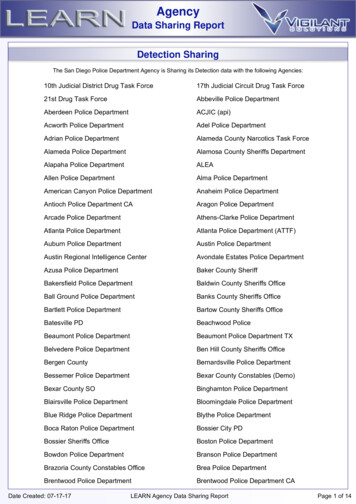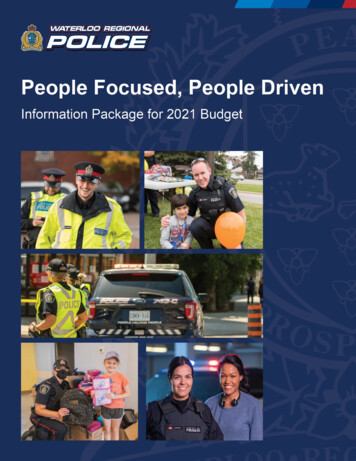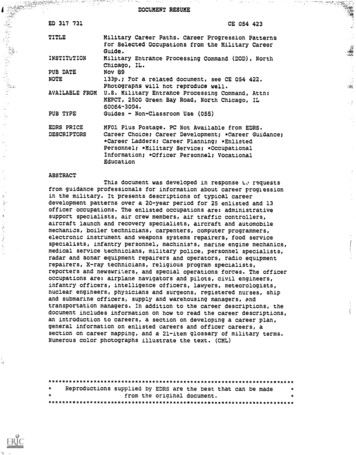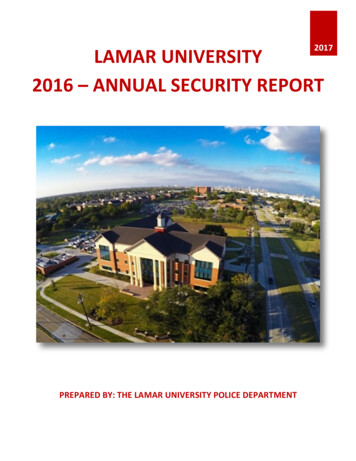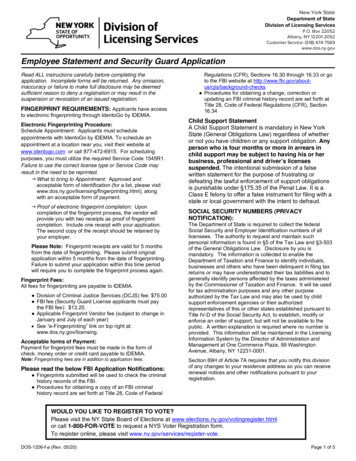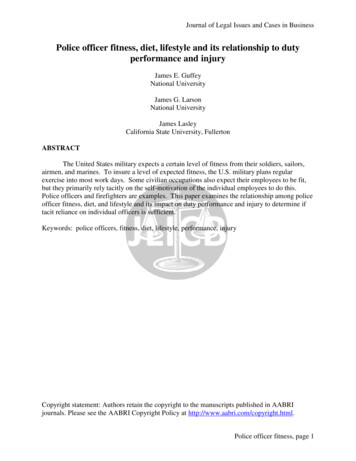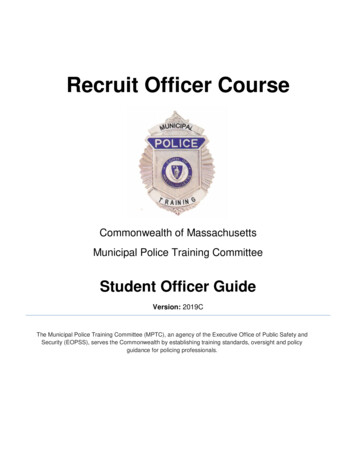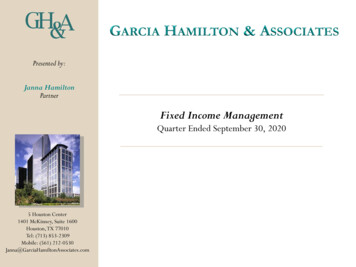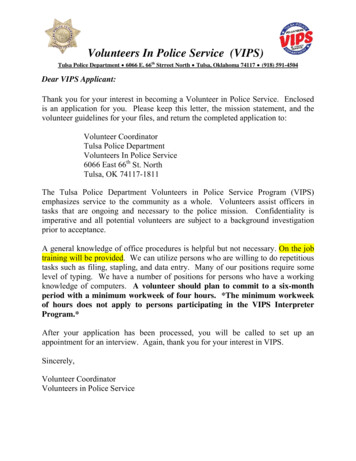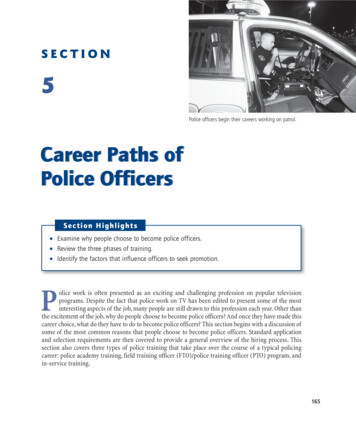
Transcription
SECTION5Police officers begin their careers working on patrol.Career Paths ofPolice OfficersS e c tiont i o n Hi g h l i g h ts Examine why people choose to become police officers. Review the three phases of training. Identify the factors that influence officers to seek promotion.Police work is often presented as an exciting and challenging profession on popular televisionprograms. Despite the fact that police work on TV has been edited to present some of the mostinteresting aspects of the job, many people are still drawn to this profession each year. Other thanthe excitement of the job, why do people choose to become police officers? And once they have made thiscareer choice, what do they have to do to become police officers? This section begins with a discussion ofsome of the most common reasons that people choose to become police officers. Standard applicationand selection requirements are then covered to provide a general overview of the hiring process. Thissection also covers three types of police training that take place over the course of a typical policingcareer: police academy training, field training officer (FTO)/police training officer (PTO) program, andin-service training.165
166PART I OVERVIEW OF THE POLICE IN THE UNITED STATESyy Choosing a Career in PolicingThe career paths of individuals who choose to become police officers begin with them making the decisionto apply. Research indicates that people choose careers in policing for an opportunity to help other people,a good salary and job security, a job that is exciting, and the prestige that comes with being a police officer.1Surprisingly, men and women give very similar responses when asked about their motivations for becoming police officers.2 A recent study of police recruits in the New York City Police Department revealed that,in general, motivations for pursuing policing careers were also similar across all racial/ethnic groups.3Police cadets in the Los Angeles Police Department reported that they had decided to become police officers several years before they had actually applied for the job—they stated that it was something that theyhad always wanted to do.4 There are other people that choose policing as a career as a result of recruitmentefforts by police agencies.yy RecruitmentPolice agencies use a variety of recruitment techniques to attract the best applicants. Visiting technicalschools, community colleges, and universities is a common recruiting practice used by police agencies.Potential applicants are also reached through career fairs, advertisements in newspapers, television andradio, and Internet recruiting websites. Some police agencies begin the recruitment process early by visitinglocal high schools. The Explorers program is anotherway to spark interest in a policing career early on inyouth populations. The Explorers program gives youtha hands-on look at the profession by allowing them toparticipate in activities with officers from local policeagencies. This is a program offered in cities across theUnited States.5 All of these recruitment efforts areimportant, as they have a direct impact on the qualityof police officers that are ultimately hired.The diversification of police agencies has becomean important part of the recruitment process forAmerican police agencies. Agencies specifically seeking female applicants highlight their family-friendlypolicies to attract women who might have otherwisebelieved that having a family would be a barrier to acareer in policing.6 Female police officers also attendcareer fairs to attract female applicants, and are able toThe Explorers program introduces young people to the policinggive them first-hand accounts of what it is like to beprofession.women working in this profession. Similarly, agenciesthat are looking to expand racial/ethnic diversitywithin their organizations provide mentoring programs in which minority police officers share their experiences with minority citizens that are considering jobs in policing. Other police agencies conduct focusgroups and community meetings in racially diverse neighborhoods to attract more diverse applicants.7Many police agencies have found that they need to go beyond traditional recruiting efforts if they want toattract a more diverse pool of applicants.
Section 5 Career Paths of Police OfficersStandard Employment RequirementsU.S. citizenship/driver’s licenseResidency requirementsMinimum age 21 yearsEducation—at least high school diplomaHeight proportionate to weightVision—varies across agenciesCriminal record—no feloniesyy What Are Some of the Common Requirementsfor Hiring Police Officers?There are no national, standardized employment requirements imposed on police agencies in the UnitedStates. Requirements for employment vary from state to state and agency to agency. This variation inemployment requirements explains why police agencies are so different from one another across the country. Most police agencies, however, do have standard employment requirements in the following areas:U.S. Citizenship/Driver’s LicenseBeing a citizen of the United States is a nearly universal requirement that needs to be met in order to becomea police officer in any state in the United States.8 A valid driver’s license is also a universal requirement tobecome a police officer.Residency RequirementsResidency requirements vary from one police agency to the next. Some police agencies require theirofficers to live within the city limits of the communities they serve, while other agencies do not. Lessrestrictive residency requirements might allow their employees to live no further than a certain numberof miles away from police headquarters. Residency requirements have been debated for some time andhave even been contested in court. In general, residency requirements have been deemed constitutional byfederal level courts as long as the employing agency can demonstrate that there is a rational basis for sucha requirement.9Reasons police officers should be required to live within the communities they serve include theidea that this will allow them to better understand the needs of their community; they will have agreater stake in serving the community; they will contribute to the local tax base; it could reduce absenteeism of officers; and it allows police officers to respond quickly if they are needed in emergency situations.10 In contrast, there are many reasons to oppose residency requirements, including the idea thatit could disqualify otherwise qualified applicants that live outside of the community; police officers willbe able to provide quality services even if they do not live in the communities they serve; and officersshould be given the choice to live wherever they want to live—housing in some cities is very expensiveand could cause financial hardship for police officers forced to live there.11 This requirement hasbecome negotiable in some jurisdictions when police agencies have had difficulty attracting qualifiedapplicants within the community.167
168PART I OVERVIEW OF THE POLICE IN THE UNITED STATESAgeThe minimum hiring age commonly used by police agencies in the United States is 21 years old.12Recently, there has been discussion about raising the minimum hiring age beyond 21 years old.Justification for increasing the age requirement is based on the idea that chronological age may notreflect an individual’s maturity level; thus, raising the hiring age by a few years will give people moretime to mature. The opposing side of this debate asserts that if the age is raised too high, it will reducethe overall size of the pool of applicants. On November 5, 2010, the Chicago Police Departmentannounced that it had raised its minimum hiring age from 21 to 25 years old. Police SuperintendentJody Weis stated that this increase in the minimum hiring age was an effort to encourage a more maturepolice force.13EducationNearly all local police agencies in the United States have some kind of education requirement as partof their hiring standards.14 A majority (82%) of local police agencies require that applicants have ahigh school diploma, while 6% require some college credits but no degree, 9% require a 2-year degree,and 1% requires a 4-year degree.15 When these statistics are compared to those from previous decades,it is clear that police officers are becoming more educated in the United States over time. But does anincrease in education requirements result in better police officers? This question has been studiedextensively over the last four decades. In the Roberg and Bonn article included at the end of this section, the impact that higher education has on police officer attitudes and job performance is discussedin detail.Height/WeightMany police agencies in the United States used height and weight requirements as part of their selectionprocess for hiring until the late 1970s.16 Some agencies required that applicants weigh at least 150 poundsand measure 5’8” or taller.17 This requirement had an exclusionary effect on women and some racial/ethnicminorities interested in becoming police officers. Under Title VII of the 1964 Civil Rights Act, the courtsdetermined that this screening requirement was discriminatory, as it would disqualify a higher percentageof female applicants when compared to male applicants.18 Further, the courts ruled that this requirementwas not an accurate way to assess whether someone could do the job. Most agencies eliminated this requirement after the Supreme Court ruling in the case of Dothard v. Rawlinson (433 U.S. 321, 1977).19 Today, someagencies use a modified version of this requirement by requiring that applicants’ height is proportionate totheir weight; however, most police agencies will assess whether someone is physically capable of doingpolice work by requiring them to complete a physical agility exam.20VisionMany police agencies have a vision requirement. The level of vision required by applicants varies fromone agency to the next. In most agencies, peripheral vision must be normal and there cannot be a history of eye disease.21 It is important to have good vision when performing most job-related tasks, butany problems with vision can jeopardize both a police officer and public safety in this particular lineof work.
Section 5 Career Paths of Police OfficersCriminal RecordAccording to recent statistics, all local police agencies in the United States conduct criminal record checkson all applicants as part of the hiring selection process.22 Most police agencies will not hire people that havebeen convicted of felony charges, as most state Police Officer Standards and Training (POST) programs willnot allow certification of people with such convictions.23 There is great variation from one police agency tothe next regarding the type of violations that will be allowed as part of the hiring process. Many police agencies have a list of the criminal violations that are either tolerated or not on their department website.24In the past, when police agencies have lowered their hiring standards, the results have been disastrous.For example, in 1988, Congress required the District of Columbia to hire 1,500 new police officers within a20-month time period or it would lose 430 million of aid. This rushed hiring process (which involvedlowering hiring standards) resulted in more than half of the officers hired during that timeframe eitherbeing arrested or being brought up on criminal charges.25 Similarly, many of the officers that were involvedin the 1998 Rampart scandal in the Los Angeles Police Department were hired during a time when employment standards were lowered. Many of the Rampart police officers had been previously convicted of avariety of criminal acts, including selling marijuana, domestic violence, grand theft, and driving under theinfluence.26 After investigating the police officers that were directly involved in this scandal, the Los AngelesPolice Department concluded thatWhile it is impossible to substantiate completely, it appears that the application of our hiring standards was compromised when these officers were hired during periods of accelerated hiring in thelate 1980s and early 1990s. . . . Several employees were aware of the Department hiring people withprior gang affiliations, drug use and criminal histories.These examples demonstrate the importance of maintaining high employment standards for policeofficers.yy Selection ProcessThe process of becoming a police officer goes beyond filling out an application and meeting the minimumemployment requirements. This process can be lengthy (6 months or longer) and requires applicants todemonstrate that they are both physically and mentally fit to be effective in this profession. The selectionprocess varies from one police agency to the next, but there are some general steps used by most policeagencies across the United States. The steps in the selection process also vary in the order of occurrenceacross police agencies.Written ExamOnce it has been determined that the minimum standard requirements have been met by applicants, theywill likely be asked to take a written examination. Most (80%) American police agencies serving populations of 25,000 or more require applicants to take a written aptitude exam.27 Written exams measure readingcomprehension, vocabulary skills, and, in some cases, analytical and problem-solving skills. The content ofwritten exams varies from one agency to the next. Many police agencies tailor written exams to measureskills that they feel are important for police officers working in their communities. Exams are graded and169
170PART I OVERVIEW OF THE POLICE IN THE UNITED STATESthen rank ordered from the highestto the lowest score. Exam scores areoften combined with other scoredrequirements for each applicant overthe course the hiring process todetermine each applicant’s overallranking in the pool of candidates.Physical Agility ExamApplicants will be asked to take aphysical agility test to determine ifthey are capable of meeting thephysical demands of police work.Most (90%) police agencies servingApplicants are required to demonstrate that they are physically able to do the job.populations of 25,000 or morerequire applicants to complete aphysical agility test.28 Physical agility exams require applicants to do push-ups, do sit-ups, and run aspecified distance to judge their cardiovascular endurance levels. Some police agencies also utilize obstaclecourses to test an applicant’s physical agility. There has been some controversy over the use of agilitycourses, as they often disqualify a high percentage of female applicants.29 Research on this topic finds thatphysical agility courses do not reflect the skills that police officers actually need to be able to provideadequate services to the public.30Oral InterviewNearly all (99%) police agencies require their applicants to participate in an oral interview with a panel ofprofessionals.31 The composition of professional panels varies from one police agency to the next, but policeexecutives, civil service representatives, human resource personnel, and, in some instances, citizens fromthe community could be part of this group. Like many of the other steps in the hiring process, the contentof the questions asked during an oral interview will vary across agencies. Some general questions that couldbe asked may be related to why an applicant wants a job in that particular agency; why he or she wants a jobin policing (in general); or how the person might respond to hypothetical situations (i.e., would you writeyour own mother a speeding ticket?). In some cases, applicants are asked questions regarding elements ofcrimes or criminal code for their jurisdiction.Medical and Psychological ExamsApplicants will also be asked to take both medical and psychological examinations. Many police agenciesleave these examinations for the end of the screening process because of the costs associated with suchservices. A majority (89%) of American police agencies require medical examinations to ensure thatapplicants are in good physical condition.32 The examination includes elements of routine annual physical examinations conducted by physicians. In addition, audiograms (hearing), vision testing, pulmonaryfunction testing (breathing), chest x-ray, electrocardiograms (heart function), and cardiopulmonary
Section 5 Career Paths of Police Officersstress tests (heart and lungs) are sometimes included in medical exams.33 Drug testing has become partof the medical examination in some agencies. In fact, most (83%) police agencies require drug testingprior to being hired.34Psychological screening is used by many (72%) police agencies as part of the screening process.35 Thetype of test used in psychological screening varies across police agencies; however, the MinnesotaMultiphasic Personality Inventory (MMPI) is often used to assess the psychological state of applicants.36The MMPI screens for psychological issues, including paranoia, schizophrenia, depression, and manicbehaviors.37 The Inwald Personality Inventory is another test that is used during the screening process. Thisinstrument is used to identify negative personality traits, including rigidity, loner mentality, emotionalinstability, impulsivity, antisocial attitudes, and difficulty with interpersonal relationships.38 This “screeningout” approach has been criticized because it focuses on identifying negative traits while failing to identifypeople who have positive traits that would be suitable for this profession.39Record Checks/Background InvestigationNearly all (99%) police agencies conduct a background check on applicants.40 The depth of backgroundchecks varies across agencies, but in general, this usually involves telephone interviews with neighbors,teachers, personal references, and former employers. It is also at this stage in the process that applicants’driving, criminal, and credit records are examined. Recent statistics indicate that all police agencies checkto see if applicants have criminal records, and nearly all (99%) agencies check driving records.41 The inclusion of credit history as part of the background investigation is becoming common in police agencies. Forexample, 70% of police agencies serving populations of 25,000 or more looked at the credit scores of applicants in 2003; this increased to 83% in 2007.42Polygraph ExaminationPolygraph examinations are not used as frequently in the hiring process compared to some of the otherscreening techniques mentioned in this section. Only half (50%) of local police agencies require applicantsto take a polygraph exam.43 This practice has become less common over time, as it is expensive and theaccuracy of this test has been challenged in court.44 It has been suggested that if police agencies choose touse this screening approach, they should use it to deter lying instead of detecting lying.45 In addition, theresults of such an exam should not be weighted as heavily as other parts of the screening process, as theaccuracy of its results is debatable.Assessment CentersAn assessment center is a place applicants go to participate in a series of situational exercises thatsimulate responsibilities and working conditions of police officers.46 The situational exercises are used toassess applicants’ abilities to work in teams, their communication skills, and their ability to interact withthe public.47 They are another tool that is used to supplement (not replace) the traditional screeningprocess used by police agencies. Slightly more than one-third (35%) of all local police agencies useassessment centers as part of their hiring process.48 The high cost of using assessment centers prohibitssome agencies from utilizing this tool in their screening process.49 But are assessment centers better thantraditional cognitive exams for predicting who will be good police officers? Joan Pynes and John171
172PART I OVERVIEW OF THE POLICE IN THE UNITED STATESBernardin conducted a study comparing the predictability accuracy of traditional cognitive exams (penand-paper format) and assessment center exercises.50 This study revealed that traditional cognitiveexams were better predictors of police academy performance, while assessment centers were betterpredictors of on-the-job performance.If applicants successfully make it to the end of the selection process and are offered a job, they will berequired to enroll in a police academy. In some places, people are not allowed to enter academy training untilafter they have been offered a job with a police agency.51 People who have been offered a job prior to enteringthe police academy would be paid all or a portion of the salary they will receive once they are done withacademy training, and the agency may also cover all or some of the costs of academy training. In contrast,some agencies require people to complete police academy training before they begin the screening process.52The drawback of entering police academy training before having a job offer is that the individual would beresponsible for paying for his or her own police academy training.yy TrainingPolice officers go through three stages of training over the course of their careers: police academy training,field training officer (FTO)/police training officer (PTO) program, and in-service training. Each phase oftraining provides officers with the information and skills that are necessary to be effective in this position.Police Academy TrainingPolice academy training is the first phase of training for police officers. The purpose of academy trainingis to teach police cadets about what is expected of them once they become police officers and also theproper way to conduct police work. In 2006, there were 648 state and local law enforcement trainingacademies providing basic training skills across the United States (98% of these academies wereapproved by state agencies).53 The average police academy program lasts 19 weeks or 761 hours (notincluding field training requirements).54 The average number of training hours (including both classroom and field training) is 1,370 hours.55Police academy training has both a classroom and field training component. The topics covered in theclassroom portion of academy training vary from one academy to the next; however, there are several topicsthat are covered by most police academies:56 Criminal law (average of 36 hours)Constitutional law (average of 12 hours)Cultural diversity (average of 11 hours)Community policing (average of 8 hours)Mediation/conflict management (average of 8 hours)Report writing (average of 20 hours)Ethics (average of 8 hours)Some police academies offer training on a variety of specialty topics, including domestic violence,interacting with juveniles, terrorism, hate crimes, and handling hazardous materials.Training in the field is also part of police academy training. This type of training focuses on the physical aspects of police work. Some common topics covered in field training include:57
Section 5 Career Paths of Police Officers173 Firearm skills (average of60 hours) Self-defense skills (averageof 51 hours) Health and fitness training(average of 46 hours) Patrol (average of 40 hours) Investigations (average of40 hours) Emergency vehicle operation(average of 40 hours) Basic first aid skills (averageof 24 hours)Firearms training is just one of several practical applications covered in the academy.Police academies have been criticized for not incorporating more training related to community policing and problem solving into their curricula.58 The criticism comes from the idea that most police agenciesclaim to have adopted community policing and problem-oriented policing practices (which rely less onphysical skills), but a large portion of police academy training is focused on the physical aspects of the jobinstead of skills related to community and problem-oriented policing. Another criticism is that the academycurriculum reinforces the idea that masculinity and aggressiveness are valued and necessary traits associated with being a police officer. An emphasis on such traits can make police academy training difficult forsome women.59FTO/PTO ProgramsThe field training officer (FTO) program was developed in San Jose, California, in 1972.60 This stageof training requires newly sworn police officers to apply what they have learned in the police academyto real-life situations on the streets while being observed by field training supervisors. The FTO program also helps to determine who will be able to function effectively as police officers. There are severalgeneral phases included in most FTO programs:61 (1) an introductory stage in which recruits learnabout policies and procedure that are unique to their agency; (2) training and evaluation phases inwhich recruits are introduced to more difficult tasks associated with policing; and (3) the final evaluation phase in which recruits work independently while they are being critiqued by field training supervisors. FTO programs have been criticized because they do not contain elements of community orproblem-oriented policing.62A new postacademy training program, the police training officer (PTO) program, was created in theearly 2000s through funding provided by the Office of Community Oriented Policing Services in Washington,DC.63 The Reno, Nevada, Police Department worked in conjunction with the Police Executive ResearchForum (PERF) to study the training needs of police agencies across the country. Based on findings from thisstudy, the new PTO program was designed around the concept of problem-based learning. Problem-basedlearning is a process that helps officers develop problem-solving skills, the ability to be critical thinkers, andskills to work well in a team setting. 64
174PART I OVERVIEW OF THE POLICE IN THE UNITED STATESThe PTO program is composed of eight phases.65 (1) Orientation phase provides information beforetrainees enter the field training program. (2) Integration phase teaches trainees about department resources,their agencies’ administrative procedures, and the PTO process. (3) Phase A is the initial training, whichemphasizes nonemergency incident responses. (4) Phase B is the second training experience, which focuseson emergency incident responses. (5) Midterm evaluation allows PTO supervisors to evaluate the progressof trainees at the midway point to determine if additional training is needed or if the trainee can move onto the next phase. (6) Phase C focuses on training related to patrol-related activities. (7) Phase D centers ontraining related to criminal investigations. (8) Final phase once again requires trainees to demonstrate theirabilities in front of PTO supervisors. If trainees have difficulty with certain tasks, they will be allowed to goback for additional training. If trainees do not demonstrate appropriate levels of ability after they receiveadditional training, they will be terminated.The PTO program is different from the FTO program, as it is emphasizes problem-based learningskills that enhance problem solving and critical thinking, while the FTO program focuses on developingmechanical repetition skills and rote memory capabilities.66 The FTO program places great emphasis onapplied skills, which include defensive tactics and shooting abilities, while the PTO places great emphasison problem-solving and critical-thinking skills. The PTO program was designed to be flexible so that eachindividual agency can tailor the training to fit its individual needs, while the FTO program is structuredin a more general manner based on the assumption that most police agencies function in the same way.67The PTO program is viewed as more reflective of both problem-oriented and community-based policing,while the FTO program is based on a more traditional policing model. Thus far, there has not been anationwide adoption of the PTO program, but some police agencies are choosing PTO programs over FTOprograms today.In-Service TrainingIn-service training takes place over the course of police officers’ careers once they have completed bothacademy and FTO/PTO training. Nearly all (92%) local police agencies in the United States require theirofficers to participate in some type of in-service training each year.68 The type of training and the numberof required hours varies from one agency to the next. Recent statistics indicate that the average number ofin-service training hours required by American police agencies each year is 35.69A wide range of topics can be included in this phase of training. Training in certain areas may berequired of police officers each year (such as firearms or defensive tactics training); however, officers mayalso be able to choose from some elective topics. Some examples of elective training topics include problemsolving skills, computers, equipment (such as breathalyzers or nonlethal weapons), search and seizure,domestic violence, crime scene investigation skills, and interview and interrogation skills.70 This type oftraining is important because it helps police officers stay current on any changes that may impact theirwork, and it allows them the opportunity to continually refine their policing skills.yy PromotionPromotion within police organizations is a way to facilitate organizational continuity and reward officersthat demonstrate excellence at work. The promotion option also provides police officers the opportunity tolearn new skills and take on additional responsibilities that can expand their roles within the organization.Promotional opportunities may also keep police officers from getting bored with their work and, as a result,
Section 5 Career Paths of Police Officers175increase their commitment to the job.71 The availability of promotion opportunities differs from one agencyto the next, with large police agencies providing moreopportunities for advance
Section 5 Career Paths of Police Officers 169 Criminal Record According to recent statistics, all local police agencies in the United States conduct criminal record checks on all applicants as part of the hiring selection process. 22 Most police agencies will not hire people that have been convicted of felony charges, as most state Police Officer Standards and Training (POST) programs will
